Article by Michael Connick
Firearms and weapons tactics are something of specialty for me, so I have great interest in the weapons used by James Bond. Accordingly, I decided to write this article discussing the various firearms used by Bond in the Fleming novels. If this is well received, I might do the same for the firearms used in the movies.
However, one thing that needs to immediately be acknowledged about Ian Fleming is that he had very little interest in firearms. When questioned regarding some inaccuracies regarding Bond’s weapons, he is reported to have said, “Quite honestly, the whole question of expertise in these matters bores me.” So, I’ll try not to be too great a nitpicker on this topic, since Fleming was otherwise a great writer and fantastic story teller. Not everyone need be as obsessed with accuracy as I am!
Bond’s Revolvers
The very first handgun mentioned in the first James Bond novel, “Casino Royale”, is the “.38 Colt Police Positive with the sawn barrel”, kept under Bond’s pillow. Ian Fleming actually owned one of these pistols, although his had a full-length barrel.
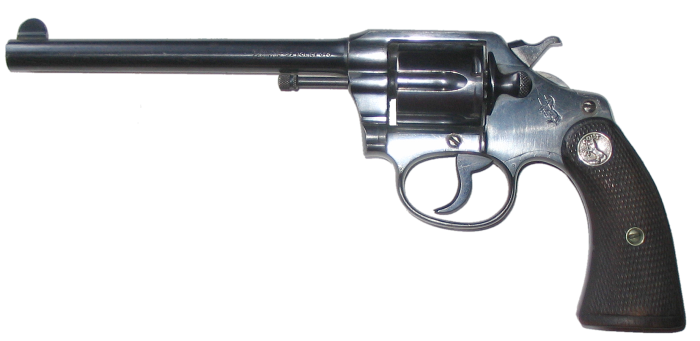
Colt .38 Police Positive with 6” Barrel
This gun is actually an unusual choice. The novel was published in 1953, but the Police Positive was already an old and unpopular revolver design by that time. It was first manufactured in 1907 and was chambered in .38 S&W. It was intended to be used as a full-sized service weapon carried in a uniformed police officer’s holster, and it was a big gun. It carried 6 rounds in its cylinder. The revolver was available with a 4″, 5″ or 6″ barrel. The barrel certainly needed to be shortened if you wanted to make it a concealable handgun. You could likely cut the barrel length down to about 2-1/2” without compromising its operation.
One problem with a sawn barrel is that you would lose the front sight of the handgun in the process. This would make the gun useless for shooting at anything other than very close-range targets. The effective range of the handgun would likely drop down to just 2 or 3 yards. It would take some sophisticated gunsmithing to put a properly aligned front sight onto a sawn revolver barrel.
A better “under the pillow” revolver made by Colt would have been their famous Detective Special. Bond uses this revolver in “Live and Let Die” and “Moonraker”, so he must have eventually caught on to the fact that this handgun was a better small revolver than his sawn barreled Police Positive.
The Detective Special came with a 2″ barrel, and had a frame that was smaller and lighter than the Police Positive’s. It carried 6 rounds of .38 Special, and .38 Special rounds are more powerful than the .38 S&W rounds that the Police Positive fired. It was an extremely popular revolver during the 1950’s for use as a concealed handgun. Many police detectives and Federal agents carried this revolver concealed on their persons during this time period.
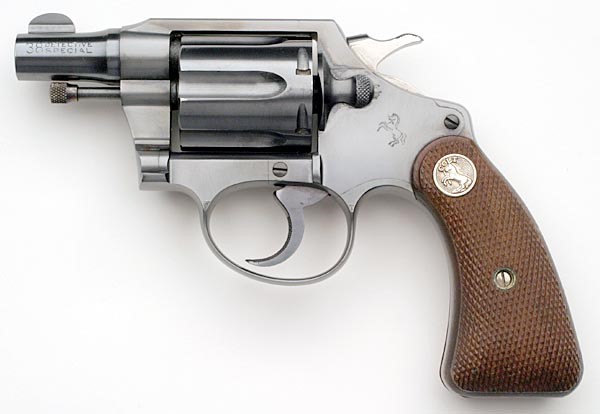
Colt Detective Special with 2” Barrel
One last revolver appears in the Bond novel “Dr. No”, and is described in this passage: “’Smith & Wesson Centennial Airweight. Revolver. 38 caliber. Hammerless, so it won’t catch in clothing. Overall length of six and a half inches and it only weighs thirteen ounces. To keep the weight down, the cylinder holds only five cartridges. But by the time they’re gone,’ Major Boothroyd allowed himself a wintry smile, ‘somebody’s been killed. Fires the .38 S&W Special…’”.
S&W invented both the .38 S&W and the .38 S&W Special cartridges. The .38 S&W Special is usually just referred to as the “.38 Special”. Regardless of what it’s called, it’s a fine defensive cartridge, and the same one used in the Colt Detective Special.
The main difference between these two guns is the lack of a visible hammer on the Centennial. It’s not truly “hammerless”, as it does have a hammer similar to that of all other revolvers. It’s just that the hammer is concealed inside a shroud on the rear of the revolver.

Smith & Wesson Centennial Airweight. (Note the lack of a visible hammer.)
This is a small and very reliable gun that Smith & Wesson continued to evolve over the years, I actually had a later version of this revolver, the Smith & Wesson 642 Airweight, and carried it as my regular concealed handgun for a few years. It never failed me and was surprisingly accurate for such a small revolver.
The Mysterious “Long-Barreled Colt Army Special .45”
Another gun mentioned in “Casino Royale” is the “long barreled Colt Army Special .45” that Bond kept in a hidden holster under the dashboard of his Bentley. The long-barreled Colt .45 is also mentioned in Goldfinger, carried “in a trick compartment under the driver’s seat” of Bond’s Aston Martin. What the heck is this handgun?
There is no handgun with that precise name. The closest to that name is the classic Colt Single-Action Army revolver chambered in .45 Long Colt. It was introduced way back in 1873 and acquired the name “The Peacemaker”. This revolver was available with a very long 7-1/2” barrel. The gun was called “single-action” because the hammer had to be manually cocked each time it was fired. It was a very popular firearm used by the US Army and civilians alike. It was carried by many a cowboy in the Old West. It’s actually still being manufactured today and is highly prized by gun collectors, cowboy reenactors, and cowboy action shooting competitors. Could this be the gun Bond has hidden in his Bentley and Aston Martin?

Colt Single-Action Army Revolver
Highly unlikely, I’d have to say, unless James is a secret cowboy wannabe. If not that handgun, then what?
I’m going to assume that Fleming, again not being all that concerned about accuracy regarding his character’s firearms, just made a bit of a mistake in naming this handgun. One key clue about this weapon is offered in the Bond short story, “From a View to a Kill”. In it, Bond fires the “long-barreled Colt”, but is nearly killed when he “kept the safety catch up”.
So, this gun has a manual safety! This almost surely makes it a semi-automatic pistol. In that case, I’m going to assume that what Fleming really meant was the classic Colt M1911 Government Model pistol, chambered in .45 ACP. This was the standard US Army sidearm for 75 years, a remarkable accomplishment for any handgun. The Government Model featured a 5” barrel. Long-slide, and thus long-barreled, versions of this handgun were made by custom gunsmiths with barrels 6” in length. So, I’m going to assume that this gun must have been a Colt M1911 Government Model that’s been modified to feature a lengthened slide and barrel.

Colt M1911 modified with long-slide and long-barrel
The Famous Beretta
The next gun appearing in “Casino Royale” is the famous “very flat .25 Beretta automatic with a skeleton grip”. The precise model name of this Beretta is never mentioned in the novels, although it appears again in “Diamonds are Forever”, “From Russia with Love”, and “Dr. No”. However, “Dr. No” does provide a clue as to which particular .25 ACP Beretta it might have been. In this novel Bond says “I’ve used the .25 Beretta for fifteen years.” This would mean that he must have acquired it sometime in the middle of WWII. This likely makes it either a Beretta 318 or 418. Since only a small number of 318 pistols were made, and the 418 was much more commonly available, I’m going to assume that the handgun is a 418. It’s probably not all that important, as these two models are almost identical in appearance and function.
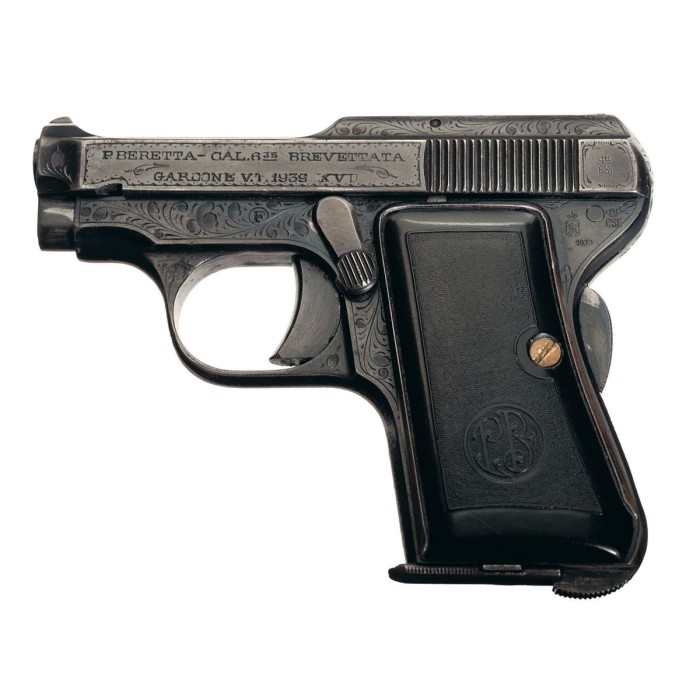
A Beretta 318, with some very nice factory engravings

A Beretta 418, this one manufactured in 1941 – right around the time Bond would have acquired his.
The Beretta 418 was a very small handgun. It was popular with Italian military officers as a pocket pistol, serving them as a backup gun for their primary sidearm, which was carried in a holster on their belts. Backup guns are very handy to have in case your primary handgun malfunctions, is lost, or just runs out of ammo. Today, most police officers in the US carry some kind of backup gun.
The 418 was also popular with German officers who were stationed in Italy. This pistol was a very small handgun, and thus extremely easy to conceal. It was small enough to be completely hidden inside a man’s hand.
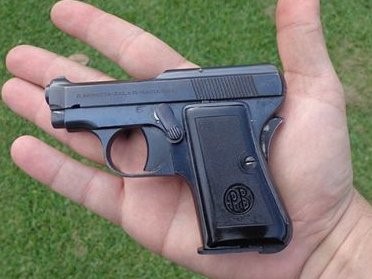
Size of the Beretta 418 compared to a man’s hand.
One thing puzzling about the first introduction of the Beretta in “Casino Royale” is the mention of its “skeleton grip”. This would mean that the side grip panels would have been removed, just leaving the skeletal frame of the grip. That would actually make the pistol, already difficult to grip because of its tiny size, even harder to hold. Why would Bond do that to his pistol?
This is another case where “more will be revealed later”, because in “Diamonds are Forever”, we are told that Bond has wrapped the skeleton grip of this pistol with tape. This would accomplish two valuable things. First, the tape could actually make the little pistol easier to hold, since it would likely be less slippery than the factory grip panels. Even more importantly, it would hold down the grip safety of the pistol. This is one of two safeties on the 418. The large lever on the left side of the gun’s frame is the first. If it’s flipped up, the gun cannot fire. It needs to be flipped into the down position, as it appears in all of the pictures, for the user to be able to pull the trigger.
The grip safety was an additional safety measure that is still found on some pistols today. It was an extremely popular design feature on pistols in the early 20th century, but much less so today. It requires that the grip be firmly grasped, pushing the safety completely into the back of the pistol, before the trigger can be pulled. The grip safety is shown clearly in all the pictures of the 418 and 318, protruding out of the back of the pistol’s grip. This sounds like a great idea at first blush, but it comes with some real problems, especially in the middle of a life or death gunfight.
If the shooter gets his hands wet from sweat, rain, or even blood, or he suffers some type of injury to his hand – any of these conditions may prevent him from getting a firm grip on the little gun. By taping all around the grip, Bond would have caused the grip safety to be pushed in, effectively disengaging it. That would allow the pistol to be fired even if held with a less than perfect grip. This makes sense for someone skilled in firearms usage. You would still have the frame safety if you really wanted to be able to put the gun into a safe condition.
Today, modern semi-automatic handguns that are designed for defensive use have no manual safeties of any kind. This includes pistols made by Glock, FN, Smith & Wesson, Beretta, and Sig Sauer. The best safety mechanism for an experienced firearms user is their brain. They just need to keep their finger off the trigger until ready to actually shoot, and to keep the trigger covered by a holster when carrying the pistol. The handgun I carry every day, a 9mm FN FNS-9 Compact, has no manual safety.
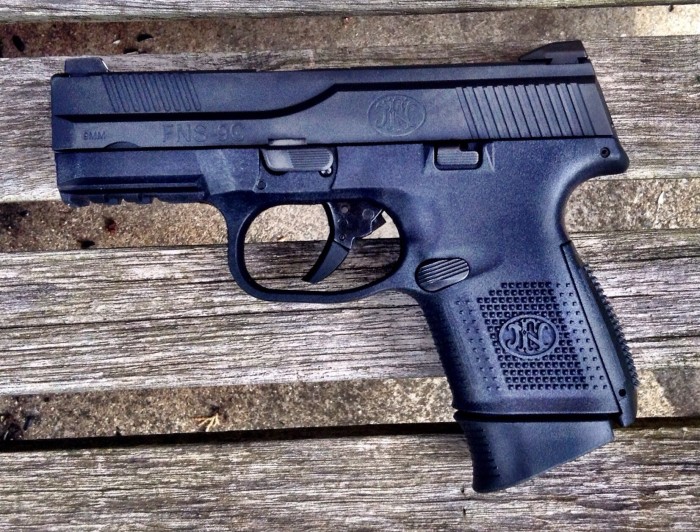
My FN FNS-9 Compact 9mm pistol doesn’t have any manual safeties.
When you are in the middle of a gun fight, you do not want to have to mess around with safeties of any kind. Remember how Bond almost got killed when he “kept the safety catch up” on his .45? You want to be able to just draw the gun from its holster and bring it into action immediately. With the grip safety taped down, Bond undoubtedly would have also left the frame safety in the down position so that his little 418 was ready for action at a moment’s notice.
So, Bond had a handgun he had happily used for fifteen years, and which he had modified for most effective use in a gunfight. Nevertheless, this little Italian pistol was replaced in “Dr. No”. Why?
In this novel, the Armourer, Major Boothroyd, is asked what the thinks of the Beretta. He answers, “Ladies gun, sir”.
There’s no doubt that the .25 ACP cartridge is very limited in stopping power compared to .38 Special or .45 ACP rounds. However, Ian Fleming himself carried a .25 ACP pistol during WWII: an FN Baby Browning, which is likely the reason he armed Bond with a .25 ACP pistol in the first place. Nevertheless, he eventually responded to criticisms and had the Armourer replace it with a German pistol that we’ll discuss later, as well as the Smith & Wesson Centennial that I mentioned above. So, was this criticism of the .25 ACP pistol fair?
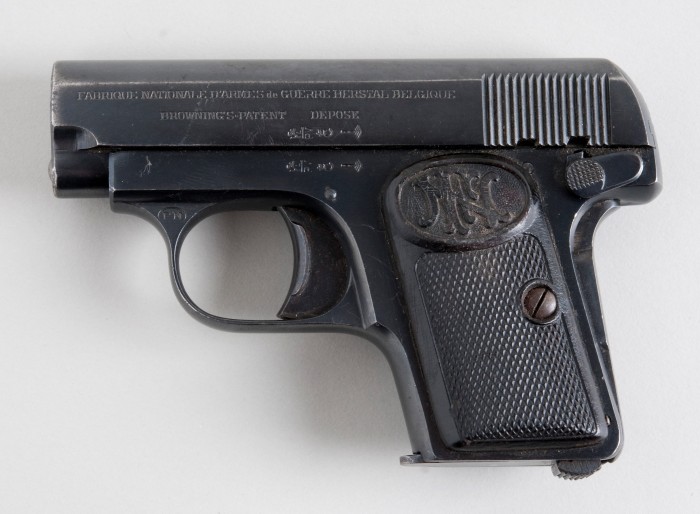
FN Baby Browning similar to the one Ian Fleming carried during WWII.
The .25 ACP cartridge is an interesting one. It was originally created in 1905 by the master firearms designer, John Browning, for use in what was then called a “vest pocket” pistol. Although it fires a small bullet with limited velocity, it’s still capable of killing a man given good shot placement. All it takes is some knowledge of human anatomy and the ability to shoot with great precision.
I happen to own a .25 ACP handgun. It’s a Raven MP-25. This is a classic “Saturday Night Special” manufactured in the 1980s and sold at that time for less than $100. Although cheaply made and a little odd looking, it’s proven to be completely reliable and amazingly accurate.
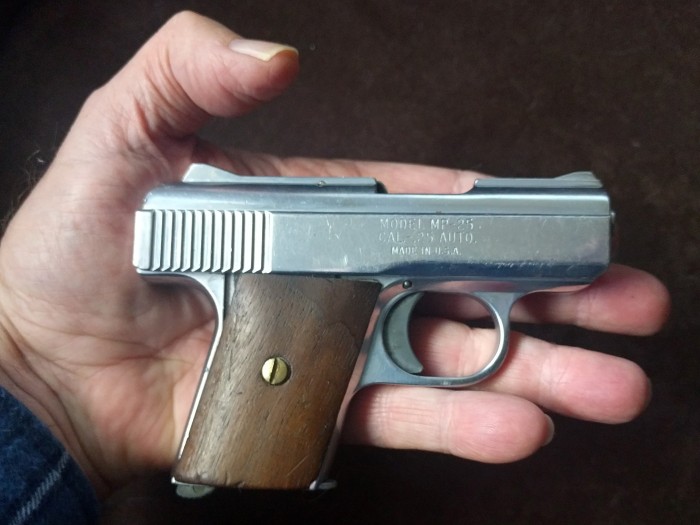
My little .25 ACP Raven MP-25 pistol.
To test the effectiveness of the .25 ACP round, I took my little Raven pistol with me to a firearms training facility. There Federal agents and law enforcement officers would be testing the ability of their handgun rounds to penetrate barriers, particularly those found in automobiles. We all shot through car windshields and car doors at targets located inside the vehicles. In every case, the .25 ACP round from my tiny Raven penetrated those barriers and hit the targets. The little .25 ACP rounds were not that puny, after all.

Putting another target inside test car. We shot this car, and one other, pretty much to pieces that day.
So, maybe Major Boothroyd was being a little harsh regarding the Beretta. Small caliber handguns, if used by well-trained professionals, can be quite lethal. The Israeli Mossad and Israeli Sky Marshal Service used .22 LR Beretta handguns for many years quite effectively and killed many terrorists with these weapons. The .22 LR cartridge is even weaker than the .25 ACP round.
The above argument regarding bullet lethality is even more relevant when you consider the caliber of the handgun Major Boothroyd recommended to replace the little Beretta.
Bond’s Best Known Pistol
This would be his Walther PPK. Made by the German firearms manufacturer Walther, PPK stands for “Polizeipistole Kurz” in German, or “small police pistol” in English. It was first manufactured in 1931 and is still manufactured today. Walther’s full-sized PP pistol was designed to be used as a sidearm for uniformed German police officers. The PPK was designed to be carried concealed by detectives, and had a shorter barrel and shorter frame. Historical trivia: Adolf Hitler owned a PPK and used it to kill himself in the Führerbunker in Berlin.
At the time “Dr. No” was written, the PPK was available in two calibers: .32 ACP and .380 ACP. The .32 ACP model holds 7 rounds in the magazine, the .380 ACP model 6 rounds. The .380 ACP round is also known as 9mm Short, and is considered by many today to be the minimum caliber that should be used for self-defense. It has a little less stopping power than that of the .38 Special cartridge in Bond’s revolvers, but still performs quite reasonably. However, Major Boothroyd gave Bond the .32 ACP version of the handgun.

Walther PPK chambered in .32 ACP.
Why? As I mentioned above, caliber is not the be-all and end-all of effectiveness when it comes to defensive shooting, but every little bit helps. I own both a .25 ACP pistol, and a .32 ACP pistol, but I choose to carry a 9mm handgun instead of either of them. If they were all I had available to me, then I’d make do. However, I’ll always go with the largest caliber handgun I can effectively carry and shoot. If I knew I was going to get into a gunfight today, I’d actually carry a rifle to it.
Handgun bullets are very weak compared to rifle rounds. The lethality of handgun rounds is greatly exaggerated in most novels, TV shows, and movies. The more foot pounds of energy my bullets can transfer into a bad guy’s body, the better. So, if given the choice I’d fight with a rifle. Unfortunately, rifles can’t be concealed very well on one’s person. That’s why Bond carries a handgun and not a rifle. That’s why I do the same.
So why would the Major choose the .32 ACP version of this pistol? I believe he had some good reasons for doing so. Perhaps it was because some people claim that the .32 ACP PPK shoots more accurately than the .380 ACP version. It would also have less felt recoil when fired. This can be very important when trying to shoot a pistol very rapidly, which is often required in a desperate gunfight. Bond had likely gotten used to shooting a very low recoil gun after all those years of using his Beretta 418, and might have found it difficult to adapt to a pistol with greater recoil. The .32 ACP pistol also carries one more round than the .380 ACP version. Having more bullets is always better. I believe these are the reasons Major Boothroyd had for recommending the smaller caliber version of the PPK pistol for Bond.
Regardless of caliber, the PPK is a fine little gun, and a very handsome one. I actually carried a Walther PPK in .380 ACP for a few years in the 1980s and really liked it. It was completely reliable and quite accurate. I’ve always liked Walther pistols and think they make very good looking and solid handguns. My wife even owns a modern day relative of this gun: the PK380 chambered in .380 ACP. She shoots it with deadly accuracy.

My wife’s Walther – a PK380.
Conclusion
So, although Fleming claimed to have little interest in firearms, he actually did a pretty good job in choosing an interesting array of handguns for Bond to use. Although I might personally have chosen different ones for him, all of them are reasonable choices for their stated purpose – providing Bond with sufficient firepower to defend himself and to use against his assigned targets.
About the Author
Michael Connick retired in 2015 from a long career with the intelligence community, the Department of Defense, and the technology industry. He has over 35 years experience working with firearms, and has participated in extensive firearms and self-defense training from governmental, law enforcement, and private organizations. He has been a fan of the James Bond novels and films since he was 16.

Author competing in a USPSA Production Division Championship match
He now resides in the little college town of Huntington, West Virginia, where he writes, competes in Action Pistol and Action Rifle competitions, and is very happily married to a truly wonderful wife. He is the author of two Cold War historical spy novels, “Trapped in a Hall of Mirrors” and “Funhouse Mirrors”. Both are available from Amazon.com and other leading booksellers. More information, including how to contact him, can be found on his web site: http://michaelconnick.com.
Incidental Intelligence
The Gun Controversy with the cover of From Russia With Love
Armed for Her Majesty: James Bond and Sherlock Holmes’ Weaponry




















Excellent article Michael – very informative.
I agree completely with your hypothesis that Fleming conflated the .45 revolver with the 1911 .45 Army issue auto. I’m sure he always meant the automatic albeit he did arm Scaramanga in TMWTGG with a .45 revolver. Perhaps he thought it fired better in gold !
I was the proud owner of a PPK before Tony Blair took it off me in 1997. A ridiculous infringement of freedoms but next to everything else he did it was probably quite minor. Anyway, all we can do now in Blighty is shoot shotguns or rifles. Now nobody ever got killed with one of those. Did they ?
I never fired the PPK in anger, only at Bisley, but it was a nice pistol.
With regard to Fleming not being interested in firearms, I don’t for a minute believe it. He was interested in all detail and I think that assertion was his defence mechanism when Boothroyd caught him out.
David, thanks for the kind words. I had a lot of fun writing this article. It took quite a bit of “detective work” on my part to nail down the specific model names for some of the firearms, and I had a great time doing it.
Pingback: The Weapons of the Literary James Bond – Michael Connick
Thanks for penning your article Michael. I enjoyed it very much. Like you, I have been a huge fan of Bond books since my teen years and have just finished Trigger Mortis and Forever and a Day, by Anthony Horowitz (recommend them both).
With regards to Flemings lack of interest in firearms details, I would think that could be quite true, in so far as specific details of certain pistols and revolvers. His background was more in intelligence, so would be concerned with strategies, rather than the tactics and tools ‘of the trade,’ I would think.
I would also assume that any ‘airing’ to firearms skills would be more based on the Fairbairn & Sykes school, which lends itself well to close quarters and the dark and dank underworld of the spy of WWII and the cold war.
My choice – In the ’80’s, I started out with a service S&W model 10, which was eventually replaced by a Glock as a secondary weapon. At the time of the books, I would have liked the reliability of a 1911, of a Browning High Power, accepting that the former would be difficult to conceal. And in true 007 style, the killing would be close up, so let’s take off the front sight and pin back the safety!
Thank’s again.
The 418 was never specifcally named? Omg now i need to go back to the books…….
Thoroughly enjoyed it.
A thought on the Police Positive.
I’m of the mind that it would have been the Police Positive SPECIAL.
Updated to fire, .38 SPECIAL or less likely .32-20.
Enjoyed you article very much. In regards to Bond’s Colt Police Positive I actually own a Police Positive circa 1910 which had it’s barrel cut down to Detective Special length and a replacement front blade added (would attach photo if i could). I image this was considered an early viable option since this revolver pre-dates the introduction of the Colt factory snub-nose around 1926? I also thought the “sawn off” might have been Fleming’s way of referring to a “Fitz Special” cut down wheelgun which was mildly popular in the US again prior to the introduction of the Detective Special.
Thank you for commenting Jeffrey!
Just to add to my previous reply to your excellent article, I have a couple of observations, with regards to the Bond firearms, which may add light to questions which have arisen.
Looking back at Fleming’s war service perhaps explains some things. His intelligence role would have made him well aware of individuals like Captain W E Fairbairn and E A Sykes, both conscripted into the British arms, after their retirement from The Shanghai Municipal Police (SMP).
Fleming liaised with all the intelligence agencies and, in 1942, was instrumental with the formation of 30 Commando. These troops were trained in unarmed combat, safe-cracking and lock-picking at the SOE facilities, where by then Fairbairn and Sykes had established the lesson plans for training the combat methods – both unarmed and with firearms.
There is plenty of information about these two formidable gentlemen out there in books and on the internet, if folk want to explore.
But to go back to my original reason for this, Fairbairn’s weapons of choice were the 1911 and various models of the Browning, in pistols and the Thompson SMG, all of which they were instrumental in introducing to the SMP years before.
Looking at the S&W .38 to start with, sawing bits of pistols is something which Fairbairn was well known for. His defensive weapon was a small revolver, with the trigger guard removed.
Fleming wrote that the barrel of the revolver had been cut down, which left the weapon with no foresight. This, in itself, would not cause a problem, as the method of instinctively pointing the weapon doesn’t require a foresight. In fact it requires no sights at all. I regularly use this method to fire at targets, as far back as 20 metres.
At the start of every Bond film there is a shot of whichever character is playing Bond, wearing a dinner suit and wielding a pistol pointing at the screen and held in one of Fairbairns shooting positions. I like to think that it is a respectful nod to the trainers of spies and commandos during WWII.
So now to look at the pistol which Michael considers probably to be a Barretta 418 and the taping up of the grip, which would hold down the safety catch. Again, looking back at Fairbairns teachings, he had the armourers of the SMP pin back all safety catches on service pistols, as officers were being shot and not having the time to release the catch.
The teaching method negates the need for a safety, as the first bullet was unchambered, when the weapon was not being deployed and part of the drawing process fed the first round, a protocol which stayed in many Law Enforcement agencies for years after WWII. In fact, the Swedish police only changed to carrying a chambered round a few years ago.
So, the point of my writing was really to suggest that, although Fleming probably didn’t know that much about firearms because that wasn’t his role, he would have known about the influence of the training methods brought from the SMP by Fairbairn and Sykes, which were deliberately designed to enable the users to win gun fights.
Thank you for such a comprehensive comment!
Hi.great article. The reason bond used a .32 cal ppk is that is was the most common pistol caliber in the world at the time.especially here in Europe.
Hi, not to hire a hall about this, but Fleming never intended the M418 to be Bond’s Beretta. I’ll say it differently; the M418 was NOT Bond’s Beretta. So which one was? None. No. Fleming did not have a specific Beretta model in mind when writing the novels. Fleming knew next to nothing about firearms. He made more mistakes about them than he got right about them. Even WITH the help later on of firearms expert Geoffrey Boothroyd, Fleming still managed to screw up his firearms descriptions and details. It’s very telling that in Fleming’s manuscript for his first 007 novel, Casino Royale, he described Bond’s gun as a “Biretta” (sp) in .29 caliber! He couldn’t spell Beretta and didn’t know there’s no such thing as .29 caliber. These are not the actions of someone who picks out a specific model in the Beretta range. Fleming wrote fiction, but he named so many real world objects in his books that people assume everything he describes is something real. The set of attributes he gives to Bond’s handgun are real, but collectively are preposterous on a real world tiny M418. CAN they be forced upon it? Yes. But WOULD any sane man actually DO them? Not on your life. So please, let’s drop this assertion that Fleming was a firearms expert, or that he intended the M418 to be Bond’s Beretta. There simply is no real world equivalent to the Beretta Fleming describes, and you know what? That’s fine.
Colt gave Ian Fleming a .357 colt python revolver in June 1964. The author died in August 1964. The gun was sold by Bonhams in 2007. https://www.bonhams.com/auctions/14881/lot/61/
About the Police Positive – you’re right that the Police Positive was old and outdated when the book was written (it was actually discontinued in 1947).
However, there were two versions of this revolver; the original Police Positive, and the Police Positive Special.
The latter gun had a slightly longer cylinder, and was available in .38 Special. It is essentially the same revolver as the Detective Special, except it has a square butt and a longer barrel.
I think Bond’s pillow gun is an ersatz Detective Special made by sawing down the barrel of a .38 Special Police Positive.
Thanks for writing, do you suppose he wrote long barrel to differentiate from the commander and officers size pistols.. so just the 5”.
While Ian Fleming was photographed with what appears to be a Colt Single Action Army revolver, the revolver used by Bond in Casino Royale and other works is more likely an M1917 revolver.
Bishop (1998) writes that the M1917 revolver was originally used by American and British armed forces during the First World War and produced by both Colt and Smith and Wesson. In 1940, the M1917 revolver was sent by the United States to Britain in large numbers to arm the Royal Navy (Bishop, 1998). Since Fleming was commissioned as a lieutenant in the Royal Navy Volunteer Reserve in July 1939, he may have seen, if not trained with the M1917 revolver during his Navy service (Pearson, 1966).
Fleming’s knowledge of firearms was inconsistent with his fictional portrayals, and while he could shoot proficiently, he could not be bothered to become an expert in firearms (Pearson, 1966). I have seen many of my fellow police officers who could shoot adequately, but did not know some pertinent details, such as the magazine capacity of their issued weapon, i.e., “I’m not a gun guy”.
This would occasionally result in getting some details wrong. For example, when writing Casino Royale, Fleming would fact-check his fictional firearms with gunsmith Robert Churchill. The exception to this was the Colt Police Positive; Fleming received a Colt Police Positive as a gift from Colonel (later General) William Donovan in 1941. Fleming would therefore write about what he knew rather than research prior to writing. It was consistent with his writing style to write the story quickly, then fact-check prior to submission (Pearson, 1966).
References
Bishop, C. (1998). The Encyclopedia of Weapons of World War II. Orbis Publishing
Pearson, J. The life of Ian Fleming. McGraw Hill Publishing.
In Diamonds Are Forever, Bond reloads the individual “spare” round (for in the chamber) via putting it back in the magazine and racking the slide. Fine.
Problem is, this implies that his magazine is always “down-loaded” i.e., physically carrying one less bullet than the mag is capable of. Because once he racked the slide, the “spare” was in the chamber and the magazine was now not full. Some spare that is!
Today, we gun carriers will rack the slide, keeping one in the chamber, re-eject the magazine and load the previously loose “spare” to the top of the magazine and then merely seat the magazine in the already loaded gun, thereby having (whatever number the magazine holds, “plus one” in the chamber)—which lets us have the maximum possible rounds, which is what everyone should want for a defensive weapon.
Back then, who knows. But it does show a smidge of a lack of gun knowledge (which is fine, I mean, it’s Britain, lol, sign of things to come, I guess). Hey, I’m happy he described what he described as good as he did.
Down-loading (I hyphenate it to avoid looking like downloading, since we are so computer oriented these days) is not necessary for handguns. There are arguments for it in rifles but the gun community will argue over that forever.
Going further, for even better realism would have been chucking the “spare” into a “for the gun range” ziplock, then grabbing a new round. Because I don’t like the wear on repeatedly chambered rounds. But hey, that’s just me at home, not me as a spy going on a mission, haha. What do I know??? 🙂